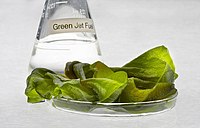
Photo from wikipedia
Objectives To evaluate mixotrophic cultivation of microalgae-bacteria consortium in raw wastewater by stepwise addition of fermented effluent containing volatile fatty acids (VFAs). Results Stepwise increase of VFAs enhanced algal biomass… Click to show full abstract
Objectives To evaluate mixotrophic cultivation of microalgae-bacteria consortium in raw wastewater by stepwise addition of fermented effluent containing volatile fatty acids (VFAs). Results Stepwise increase of VFAs enhanced algal biomass and lipid production, ammonia and phosphate removals. The highest biomass and lipid yield were 1.94 g L −1 and 310 mg L −1 when the addition of fermented effluent containing VFAs increased to 30% (v/v). With the same cultivation conditions, the maximum removals efficiency of ammonia and phosphate were 26.4 and 11.3 mg L −1 d −1 . Bacterial diversities increased with the increasing concentration of VFAs and their communities were identified as phyla Actinobacteria, Bacteroidetes, Cyanobacteria and Proteobacteria. Conclusions Although bacterial quantities increased with algae growth concurrently, the objective of culturing microalgae-bacteria consortium in raw wastewater without sterilization to produce biomass and lipid yield still can be realized.
Journal Title: Biotechnology Letters
Year Published: 2020
Link to full text (if available)
Share on Social Media: Sign Up to like & get
recommendations!